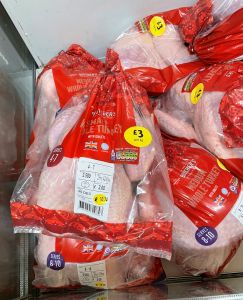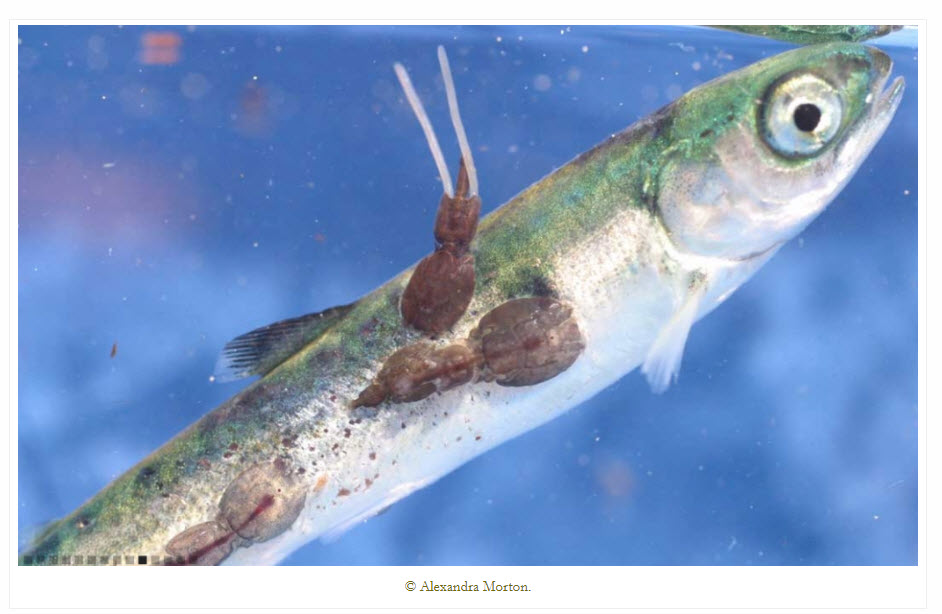Madness: The Daily Mail reported that it is now ILLEGAL (Their capitals) to leave the house in Scotland except for exercise and essential journeys. Ministers say that they are more worried about Covid than at any stage in the pandemic so far, as they close schools, places of worship and ban group exercise. However, Marine Scotland has blogged that it is permissible to travel to go angling as long as the other rules are respected.
I believe that this is absolutely the wrong decision. Not many people have a river that can fished on their doorstep and this message means that the public will bend the rules. My stepdaughter is an A&E registrar, currently working in a Covid ward in a major hospital and her advice would be to stay at home. If the public were more aware of the sacrifice that health care professionals undertake every day, then they would realise that it is madness to leave home just to go fishing.
At the same time, the angling sector complains that the iconic salmon requires protection and with the spring salmon run the most threatened, surely for the well-being of both the public and the salmon, salmon and trout angling should not be allowed to restart until at least Easter. I hope that Marine Scotland reconsider their decision.
Concerns: I mentioned the decision to allow angling because the River Helmsdale opens to fishing on Monday 11th followed by the River Tay on the 15th. If anyone should go fishing and manages to catch a salmon, it will not be officially reported until the end of April 2022. This is when the Scottish Government will publish the catch statistics for 2021. At a time, when news of unfolding events from around the world can be followed on a mobile phone, surely, there must be some way for catches to be reported and published weekly. By comparison, the angling sector have demanded that the salmon farming industry report weekly on sea lice counts. I see no difference. Of course, the reason, the angling sector is resistant to such change is that if any river reports no or low catches, then prospective anglers might decide to go elsewhere, and proprietors will lose business. Salmon angling is a business and not just some gentlemen’s pursuit and should be treated as such.
Whilst the angling sector demands that the salmon industry be more transparent, four months on from the inadvertent release of fish from the Carradale farm, I am still waiting for publication of the scale readings of recovered salmon by Fisheries Management Scotland. At the time, they asked any angler catching one of these fish to take a scale sample to confirm that the fish was of farmed origin.
This report is of interest because as I previously have written, I have heard from different sources that whilst some of the fish did enter local rivers, they left as quickly as they came. I would therefore expect most of the fish caught were from the lower reaches of the river only. If this is the case, then any perceived threat of interbreeding is unlikely to be realised. In my opinion, this is yet another example of the wild fish sector screaming and shouting about the threat to wild salmon, yet it is not backed up by the reality. The longer that FMS delay publishing their findings, the more suspicious I get. I already have some doubts.
During the REC Committee update, Ben Hadfield told MSPs that ‘about 400 fish’ turned up in rivers. Presumably, he had heard this figure from Fisheries Management Scotland, Yet the December issue of Fly Fishing & Fly-Tying magazine incudes a report which states that FMS had 155 records of fish caught of farmed origin, totalling 219 formally identified fish. This means that some of the 155 anglers caught more than one fish. I have heard elsewhere that quite a number of scale readings have identified wild fish too, highlighting that identification is not so straightforward or that anglers saw this as an opportunity to take a fish home. Such differences illustrate why FMS need to publish their report now. Given that they have the services of a specialised Interactions Manager, paid for by Marine Scotland, there is no excuse for such delays – unless their findings of course do not match their very vocal claims. So far, I am not sure what Marine Scotland’s aim was in funding this position of Interaction Manager at FMS. I would have thought it was to help foster good relations between the wild and farming sector but so far her most prominent activity was to submit a (somewhat flawed) objection to the expansion of a salmon farm. If this is the purpose of the job, then Marine Scotland should certainly consider withdrawing their generous funding package. FMS are perfectly capable of submitting objections without this added help.
One of the many vocal claims made against the salmon farming industry is that sea lice infestations have caused the decline of wild salmon and sea trout. Because there are no dead bodies to examine, it is very hard to prove a direct link, however there is sufficient evidence to indicate that the cause of the declines is not due to sea lice. SEPA have clearly come to this conclusion with Peter Pollard telling the REC Committee in November that sea lice are not responsible for the declines. Yet, if sea lice from salmon farms are not causing the decline of wild fish stocks, then I have to ask why modellers from SEPA have joined with Marine Scotland Science and Scottish Natural Heritage to model the spread of sea lice larvae from salmon farms? Sometime ago, there was talk that the Scottish Government might consider introducing a Norwegian style traffic light system to protect wild salmon. This model might form the basis of such a system, however, if this is the intention, then the Scottish Government should consider that on February 8th some of the Norwegian industry will launch a legal challenge to the system at the District Court in Førde. In addition, Norwegian research funders have commissioned a review of the traffic light system from researchers outside Norway.
Perhaps, this work began before SEPA reached their current conclusions and that if the rumours regarding a traffic light system for Scotland are true than maybe they might have already had a change of mind. After all, why have a traffic light system to protect wild fish if the wild fish are not actually threatened?
I am not a great fan of some of the models used in research about salmon farming. This is because any model is built on an assumption and typically this assumption is negative, otherwise why bother. The point of modelling sea lice spread would be to predict where local salmon and sea trout populations are at risk from spreading sea lice. Yet, if the sea lice are not a risk, then why bother. The problem is that such ideas have become so entrenched that they are difficult to counter. For example, the Scottish Government website still contains a post about the summary of the science of sea lice which suggests that sea lice are a threat to wild fish. I have written more than once about the content of two of the papers cited that supposedly show that sea lice are a threat to wild fish populations. I have even asked to be corrected if my assessment of this work is incorrect. I am still waiting for an answer.
If sea lice are not a threat to wild salmon, then I also fail to understand why Marine Scotland Science applied for money to fund a project to track smolts on the west coast. The idea is to work out migration routes, but it is also to help inform on future planning applications.
In correspondence about the £750,000 plus west coast tracking project, one of the fisheries’ scientists from the Freshwater Fisheries Laboratory wrote to the Atlantic Salmon Trust describing the nature of the main arrays. This will be formed of 70 receivers spread from Skye to the Outer Hebrides. I am somewhat mystified as to the purpose of this extensive (and expensive) array since its sole purpose appears to be to track smolts as they head north. I suppose one question could be whether smolts from the south head out to sea or swim the other way around Skye. My money would be that they head out towards the main current through the Minch to help their passage north, just as birds use winds to assist them on their migration.
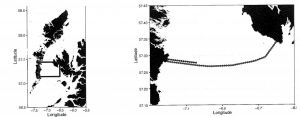
We know smolts head north and as we know from Peter Pollard at SEPA, sea lice are not responsible for the declines of wild fish, this study appears to serve little real purpose, especially a time when bigger issues face wild salmon.
Currently, the Scottish Government is putting together a wild salmon strategy using the services of a small group of ‘specialists’. So far it has proved impossible to find out who is a member of this group, or even where the minutes of their meetings are to be published. I have written before that I would expect the same people will be coming up with the same ideas as to how the future of wild salmon will be mapped out. Surely, the discussion should be open so current ideas can be challenged in order to find the best way ahead. Unfortunately, the wild salmon group sounds very similar to the Salmon Interactions Group, which was also small, and which refused to hear other views. As a consequence, we now have a flawed interactions strategy. I appreciate that this is not the best time, but iconic wild salmon merit a full and broader debate as to their future.
Canada: As I watched the events unfold on Capitol Hill in Washington, with the allegations of incitement I find it hard not to draw parallels with the recent news from the Discovery Islands. Over a much longer period of time, First Nations have been fed a constant supply of misinformation emanating from a single source and have been incited to take action against local salmon farms. The local First Nations told the Minister that they did not want farms in their neighbourhood and the Minister acceded to their demands. Why did they not want salmon farms? Simply, they have repeatedly been told that salmon farms are the reason why wild salmon stocks have declined or disappeared. Although DFO research has said this is not the case, independent ‘biologist’ Alexandra Morton appears to know better.
Over the years, I have not been impressed by Ms Morton’s science especially after watching her buy salmon from a supermarket to obtain samples and then dissecting in the car park with a dog sniffing around at her heels.
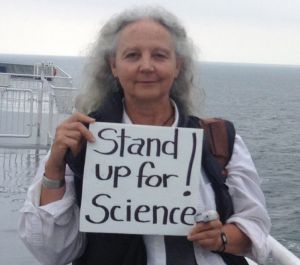
I have received a number of mails from Canada, following my comments in reLAKSation no 1001 for which I am extremely grateful. The most interesting comes from someone with whom I have exchanged mails for quite some time. It is someone I trust, and I say this because of what I am about to relate.
“I also wanted you to know that many years ago, she (Morton) and I were both participating in a local Stewardship Group- a committee set up to provide dialogue between local First Nation and the salmon farmers in the area. Naturally, she managed to squeeze herself into the proceedings. Anyway- what I wanted you to know is that at one point she expressed appreciation for a person that had found a particular type of glue that let her attach sea lice to (living) salmon. And when you look at some of her pictures/videos, it seems implausible that a tiny juvenile Pacific salmon can have naturally attached adult sea lice on it- some of them with the egg strings pointing forward- towards the head of the fish! “
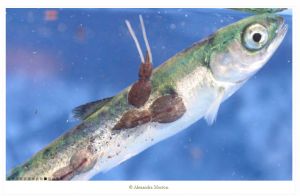
This is not the only time that an Alexandra Morton photo of sea lice appears to be misleading. In 2019, she bought a piece of salmon which included a live sea louse on the flesh side. She told DH News that this shows sea lice are out of control.
For the last nineteen years, I have been in an out of supermarkets in the UK and several European countries, two or three times a week if not more and I have never seen a sea louse on any salmon flesh. Once or twice, I have seen them on whole fish on the fresh fish counter, but it was only one. I simply do not believe that this was a genuine photo. I would certainly want to see the pack on the shelf alongside other packs to be convinced. Of course, the fact that it was Alexandra Morton that found the louse, rather than an ordinary member of the public, is what makes me suspicious.
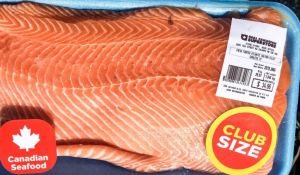
Another correspondent wrote to tell me about a report written by Peter H Pease, a commissioner for The Commission on Pacific Fisheries Policy. The report is titled Turning the Tide and was published in 1982. It is 308 pages long.
The report begins:
“We begin with a paradox. We have some of the world’s most valuable fish resources, they are capable of yielding great economic and social benefits; yet many commercial fishermen and fishing companies are near bankruptcy, sport fishermen and First Nations are preoccupied with declining opportunities to fish, and the fisheries are a heavy burden on Canadian taxpayers.
The problems now facing the Pacific fisheries are numerous, grave and very complicated. They include overfishing, conflicts among users, overexpansion of the fishing fleets, and eroding marine and freshwater habitat. As one group put it at the public hearings, “The problems in the industry boggle the mind. On every hand there is a crisis and a fundamental problem that must be solved.” And words like “dilemma,” “predicament” and “chaos” were commonly used.
Major and fundamental changes in fisheries policy are needed to correct this situation and to achieve the policy objective stated in this Commission’s terms of reference of ensuring “that fish resources and their use make the highest possible contribution to the economic and social development of the people of Canada.” “
In 1982, salmon farming in BC was very much in its infancy. The following graph showing BC salmon production is taken from the Monterey Bay Seafood Watch report.
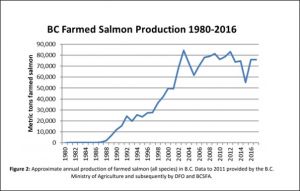
It’s clear that the problems affecting wild salmon in BC had nothing to do with salmon farming and the problems were significant. The conclusions drawn by Peter Pease was that overfishing, and the destruction of freshwater habitat were the two main causes of declines in wild salmon numbers. These, now added to climate change, would undoubtedly continue to add to the pressures on wild salmon. As I wrote last week, numbers of sockeye have also been low in rivers which have no salmon farms.
Another correspondent reminded me of the celebration dinner held by local MP Rachel Blaney to mark the announcement of the decision to remove farms from around the Discovery Islands. Her husband is Chief Darren Blaney who last September told the North Shore News that he has been opposed to salmon faming for years. He said that “As far as I could see the sockeye populations have been going down, since the farms got here,” Perhaps, he should read Peter Pease’s report. His wife is the MP for North Island – Powell River which includes the Discovery Islands. One has to wonder whether her interests have been more directed to those of her husband rather than the concerns of her other constituents.
Finally, I wanted to mention a report that appeared in the Vancouver Island Free Daily just before Christmas. This concerned the publication of a new report analysing salmon populations in the Broughton Archipelago. The authors identified 94 district populations of Pacific salmon including the chum salmon population in Viner Creek Sound. This population dipped severely during the 1980s to the point that the salmon were not replacing themselves. However, something changed during the 1990s that brought about a steady increase in population numbers. The report’s authors don’t know why.
The authors do consider some of the reasons why salmon populations have been affected. These include logging (freshwater habitat destruction) and climate change. They also mention fisheries but do not appear to discuss the implications.
Finally, they mention salmon farms and mention the work of Krkosek from 2005. This is the work highlighted by Vivian Krause as correlative not causative.
What is interesting about this report is that it has been published by the Salmon Coast Field Station founded by Alexandra Morton. Strangely, the report does not appear to have prompted any comment from Alexandra Morton herself, but then anything connected to the decision to close the Discovery Island farms is not of any surprise.
Postscript: Alexandra Morton wrote a letter to the Minister, dated 4th January which should be essential reading for all those who care about salmon farming in BC.
The letter can be found at:
https://alexandramorton.typepad.com/alexandra_morton/2021/01/dear-minister-jordan-your-decision-will-face-a-minefield.html?fbclid=IwAR2XOOj6Ma-H7cQnKjptW96bQ3HfXgVGv57jCdU5kgk1MFeZzxiQRCx3VDo
Talking turkey: Before Christmas, industry critic Derek McLay suggested that Morrison’s supermarkets were selling whole salmon cheaper than turkey. Although his Twitter name is @salmonresearch, he clearly hadn’t done much research. His pricing, taken from Morrison’s on line shopping site, was based on Morrison’s premium turkey rather than their standard offering. This was priced at £3/kg compared to the promotional price for salmon at £4.99/kg.
Salmon Business report that Morrison’s sales of salmon increased by 40% over sales last year. This is, he says, because it was cheaper than turkey.
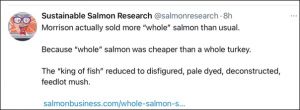
Even though his error had been corrected, he continues to promote his misinformation. Sadly, it all sounds far too familiar!
